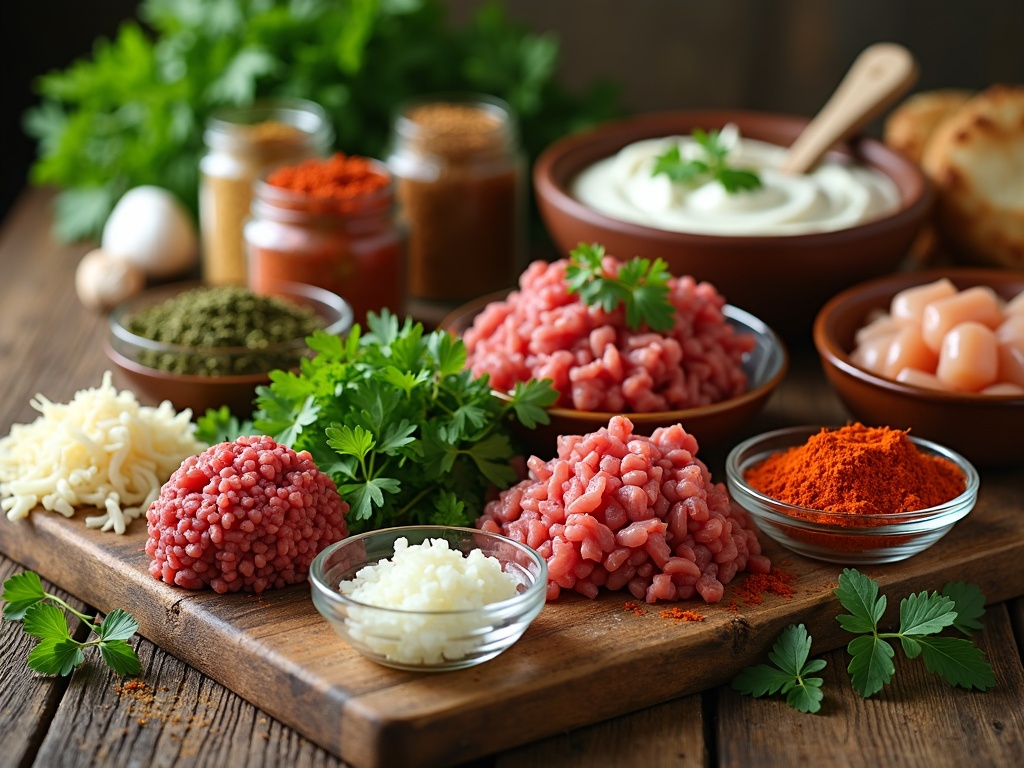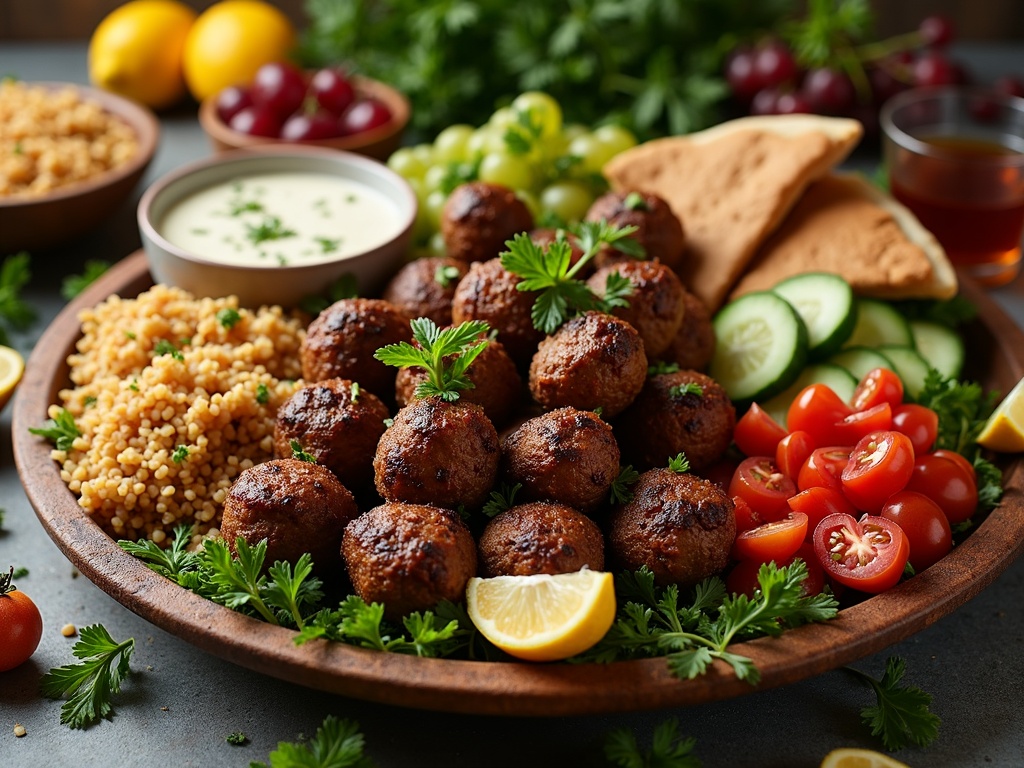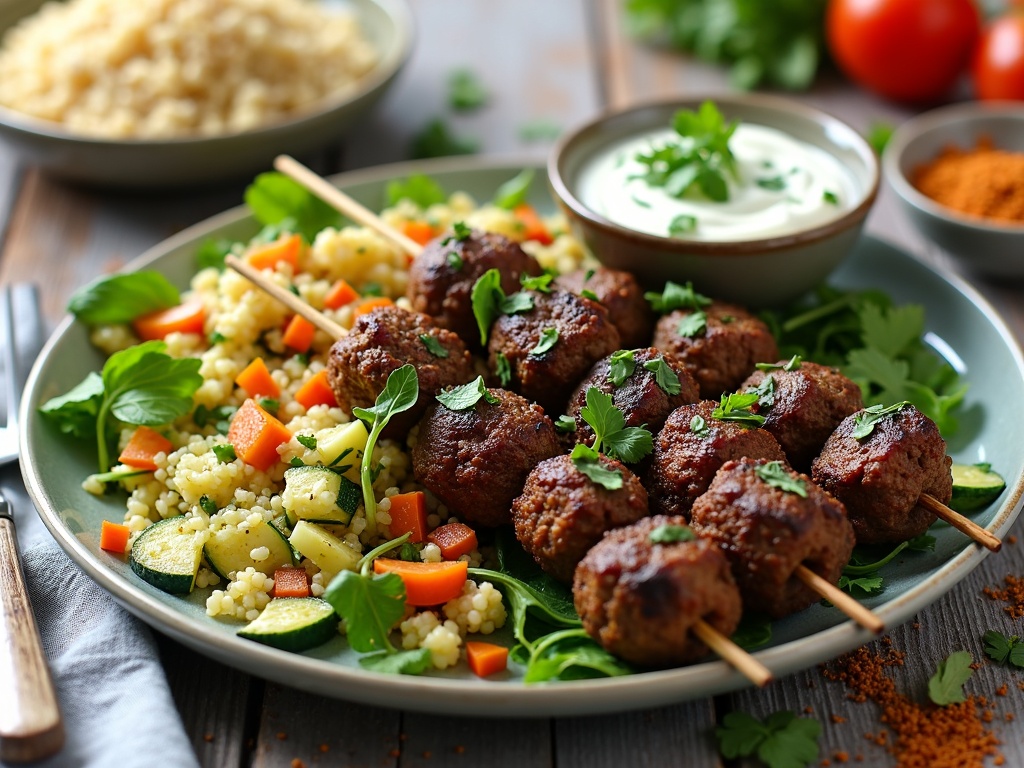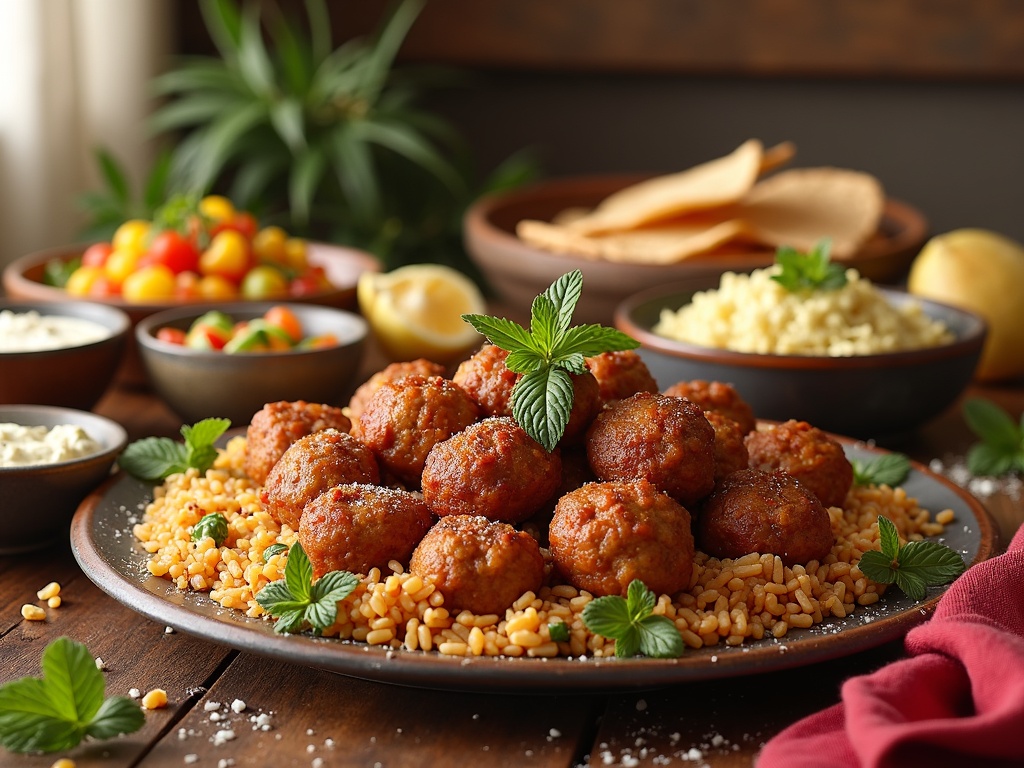Kofta recipe is a versatile and beloved dish that has evolved across Middle Eastern and South Asian cuisines, balancing bold flavors with comforting textures while adapting to local tastes in each region. This centuries-old favorite showcases incredible flexibility in preparation methods and ingredients, making it both accessible and distinctive whether grilled, baked, fried, or simmered in sauce.
Find In This Article
Key Takeaways
- Traditional kofta typically features ground lamb or beef mixed with aromatic herbs and spices, though it can be made with chicken, turkey, or plant-based alternatives like chickpeas.
- Regional variations exist across cultures, from Turkish kofte with bulgur wheat to Indian versions with paneer in rich gravies, each telling stories of cultural exchange.
- The perfect kofta requires quality ingredients including fresh aromatics (onions, garlic, herbs) and a signature spice blend (cumin, coriander, allspice, paprika).
- Cooking methods significantly impact flavor and texture—grilling provides smokiness, baking offers convenience, frying creates a crisp exterior, and simmering infuses rich flavors.
- Kofta offers nutritional benefits including high protein (23g per 3-ounce serving) and iron content, and can be made healthier by incorporating vegetables or using leaner meats.
What Makes Kofta Special
Kofta is a dish that has captured hearts and taste buds across the Middle East and South Asia for centuries. I’ve found that its enduring popularity stems from its incredible versatility and how it perfectly balances bold flavors with comforting textures. This beloved dish has traveled across continents, adapting to local tastes while maintaining its essential character.
Regional Variations and Cultural Significance
In Turkey, you’ll find kofta referred to as “kofte” – typically featuring a mixture of ground meat (often lamb or beef) combined with herbs, spices, and sometimes bulgur wheat. Turkish kofte comes in countless regional varieties, from the spicy Adana kofte to the more delicate Izmir kofte served with potatoes and vegetables.
Moving eastward to India, “kofte” takes on different forms entirely. Indian versions might incorporate paneer (cottage cheese), vegetables, or meat mixed with distinctive spice blends like garam masala. They’re often served swimming in rich, aromatic gravies rather than on skewers.
What I find fascinating is how each culture has embraced kofta as its own. In Lebanon and Syria, kofta might be served with tahini sauce and flatbread, while in Morocco, you might find it seasoned with cinnamon and served alongside couscous. These variations aren’t just about taste – they tell stories about trade routes, cultural exchanges, and the natural resources available in each region.
Versatility in Ingredients and Preparation
The beauty of kofta lies in its adaptability. Here’s what makes it such a special addition to any cooking repertoire:
- Protein flexibility: While traditional recipes often call for lamb or beef, you can create delicious kofta using chicken, turkey, or even plant-based options like chickpeas or lentils.
- Spice customization: The spice blend can be adjusted based on personal preference, from mild and aromatic to boldly spiced.
- Cooking methods: Kofta can be grilled, baked, fried, or simmered in sauce depending on the recipe.
- Serving options: Enjoy it on skewers, in sandwiches, over rice, or as part of a mezze spread.
I’ve experimented with numerous kofta recipes over the years, but I keep coming back to traditional lamb kofta for its rich flavor and perfect texture. The combination of ground lamb with garlic, onions, and warm spices creates something truly magical when cooked over an open flame. Lamb kofta exemplifies why this dish has stood the test of time – it’s straightforward to prepare yet delivers complex, satisfying flavors.
What separates great kofta from good kofta often comes down to technique. The meat mixture should be worked enough to develop cohesion but not so much that it becomes tough. Many traditional cooks insist on hand-chopping the meat rather than using a food processor to maintain the perfect texture.
The spice blend is equally important – cumin, coriander, and cinnamon are common foundations, but each family typically has their own closely guarded blend that makes their kofta distinctive. Some recipes incorporate grated onion or soaked bread to ensure moisture, while others rely on the natural fat content of the meat.
I’ve discovered that kofta isn’t just delicious – it’s also incredibly practical. The mixture can be prepared ahead of time, making it perfect for entertaining, and leftovers transform beautifully into new meals the next day. This combination of flavor, versatility, and convenience explains why kofta has transcended its origins to become a globally appreciated dish.
Essential Kofta Ingredients and Shopping Guide
Crafting perfect kofta starts with selecting quality ingredients. I’ve found that understanding what goes into this beloved dish helps me create authentic flavors every time.
Meat Selection
The foundation of any great kofta is the meat. You have several options to choose from:
- Ground lamb: Provides the most traditional and rich flavor (try Omaha Steaks for consistent quality)
- Ground beef: An excellent alternative with 80/20 fat content for juiciness
- Ground chicken: A lighter option that takes on spices beautifully (Tyson offers reliable ground chicken)
- Mixed meats: Combining lamb and beef creates a balanced flavor profile
The global meat market reached a staggering $1.2 trillion in 2021, showing just how important quality protein is worldwide. When shopping, I recommend choosing leaner options if you’re health-conscious, but remember that some fat content helps keep kofta moist and flavorful during cooking.
Fresh Aromatics and Spices
The soul of kofta lies in its aromatic ingredients that transform simple ground meat into something extraordinary:
Fresh herbs and aromatics add brightness and depth:
- Finely minced onions provide sweetness and moisture
- Fresh garlic cloves (2-3 for a pound of meat) deliver punchy flavor
- Chopped parsley adds color and freshness
- Fresh mint leaves bring a cooling element
The signature kofta spice blend creates that distinctive Middle Eastern flavor. I typically use:
- Cumin: 1-2 teaspoons for earthy warmth
- Coriander: 1 teaspoon for citrusy notes
- Allspice: ¼ teaspoon for subtle sweetness
- Paprika: 1 teaspoon for color and mild heat
- Salt: 1 teaspoon per pound of meat
For convenience without sacrificing quality, I’ve had great results with McCormick and Simply Organic spice brands. Their freshness and potency help create authentic flavors.
When shopping, I recommend buying fresh herbs the day you plan to make kofta. The aromatics should be vibrant and fragrant – this makes a noticeable difference in the final dish. For an even more authentic experience, try visiting specialty Middle Eastern markets where you might find pre-mixed kofta spice blends.
For a complete meal, consider serving your kofta with traditional accompaniments like lamb kofta with tzatziki sauce and warm flatbread.

Master Your Kofta Cooking Methods
Choosing the right cooking method for your kofta can dramatically influence its taste, texture, and nutritional profile. I’ve experimented with various techniques over the years and can help you select the perfect approach for your needs.
Exploring Cooking Techniques
Grilling delivers that authentic, smoky flavor that makes kofta truly special. I always preheat my grill to medium-high heat before cooking. Using metal skewers helps with handling and ensures even cooking throughout. The skewers also make flipping easier, preventing your kofta from falling apart or sticking to the grill. For best results, I brush the kofta lightly with oil before placing them on the grill.
Baking offers convenience and consistency, especially when cooking for a crowd. I set my oven to 375°F (190°C) and arrange the kofta on a lined baking sheet. This method produces evenly cooked kofta with minimal effort and supervision. Baking also allows you to prepare larger batches simultaneously, making it perfect for family gatherings or meal prep.
Frying creates a deliciously crisp exterior while keeping the inside juicy and tender. I heat about half an inch of oil in a skillet over medium heat and cook the kofta until golden brown on all sides. This method enhances the flavor profile significantly but does add extra calories. Fried kofta contains approximately 230 calories per serving compared to grilled kofta at around 150 calories.
Simmering in sauce is a traditional preparation method that infuses kofta with rich flavors. I form the meat mixture into balls rather than cylinders, then gently simmer them in tomato sauce or curry. This technique creates tender, moist kofta perfect for serving over rice or with bread. For an impressive meal, try my lamb kofta recipe simmered in a savory tomato sauce.
Several tips can help you achieve perfect texture and doneness regardless of your chosen cooking method:
- Test for doneness with a meat thermometer—ground meat should reach 160°F (71°C)
- Allow the meat mixture to rest in the refrigerator before shaping to help ingredients bind
- Don’t overwork the meat when mixing or shaping to avoid tough kofta
- If using wooden skewers for grilling, soak them in water for 30 minutes first to prevent burning
- Let shaped kofta rest for 15-20 minutes before cooking to allow flavors to meld
- Apply gentle pressure when forming kofta—too tight leads to dense results, too loose causes crumbling
The perfect cooking time varies by method: grilling usually takes 8-10 minutes with turning halfway through, baking needs 15-20 minutes at 375°F, frying requires 6-8 minutes with frequent turning, and simmering in sauce takes about 20-25 minutes.
Pairing your cooking method with the right meat blend also makes a difference. Fattier meats like lamb work beautifully for grilling, while leaner options may benefit from the moisture-retaining properties of simmering in sauce.
I’ve found that each cooking method creates a distinctly different eating experience. Experiment with these techniques to discover your favorite way to prepare this versatile dish—your perfect kofta is just a cooking session away.
Perfect Pairings and Presentation
I’ve found that serving kofta with the right accompaniments elevates this dish from simple to spectacular. Traditional Mediterranean sides complement the rich, spiced flavors of lamb kofta perfectly, creating a balanced and satisfying meal.
Completing Your Kofta Feast
Warm, fluffy pita bread makes an ideal companion for kofta, perfect for scooping up juicy meat and sauces. Alternatively, aromatic basmati or vermicelli rice provides a neutral base that soaks up the delicious meat juices. Fresh salads add brightness and crunch – try tabbouleh with parsley and bulgur or a simple cucumber and tomato salad with lemon dressing.
For sauces, nothing beats cool, tangy tzatziki made with yogurt, cucumber, and garlic. Smooth, creamy hummus also pairs beautifully, offering a protein-rich complement to the spiced meat. These additions not only enhance flavor but also create textural contrast.
The complete meal offers excellent nutritional balance. A typical serving of kofta with rice, salad, and tzatziki provides approximately 600 calories, making it a filling yet reasonable main course option.
For drinks, consider serving:
- Sparkling grape juice for a festive touch
- Pomegranate juice for a tart contrast
- Mint tea as a traditional pairing
- Rose water lemonade for something refreshing
Don’t forget the finishing touches! Garnish your platter with:
- Sprigs of fresh mint or parsley
- Bright lemon wedges for squeezing
- A light dusting of sumac for color and tang
- Toasted pine nuts for crunch
Presentation matters too – serve kofta on a large platter family-style for casual gatherings, or plate individually for more formal occasions, arranging the meat alongside colorful sides for visual appeal.

Health Benefits and Smart Substitutions
Kofta isn’t just a delicious dish—it’s packed with nutrients that make it a worthwhile addition to a balanced diet. When prepared with lamb, a standard 3-ounce serving provides approximately 23 grams of protein, supporting muscle repair and growth. This makes it an excellent option for fitness enthusiasts or anyone looking to increase their protein intake.
The iron content is another impressive benefit of lamb kofta. With about 2.7 mg per serving (15% of the daily recommended value), it helps maintain healthy blood cells and prevents iron deficiency anemia. Iron from animal sources like lamb is also more readily absorbed by the body compared to plant-based sources.
Enhancing Nutrition and Reducing Fat
I’ve found several clever ways to boost the nutritional profile of kofta while maintaining its rich flavor:
- Grate vegetables like zucchini, carrots, or bell peppers directly into the meat mixture for added fiber, vitamins, and moisture
- Incorporate finely chopped spinach or kale for an iron and vitamin K boost
- Add minced onions and garlic for flavor and their natural antioxidant properties
- Mix in fresh herbs like parsley, mint, or cilantro for brightness and added nutrients
For those monitoring fat intake, there are several effective substitutions I can recommend. Using lean ground lamb or a mixture of lean lamb and turkey can significantly reduce the fat content. Another option is using ground chicken breast or a combination of lean beef and chicken for a lighter version that still delivers on flavor.
The traditional lamb kofta recipe can be adapted for various dietary needs without sacrificing taste. For instance, using egg whites as a binder instead of whole eggs cuts cholesterol, while adding a small amount of olive oil maintains juiciness in leaner meat versions.
Spices play a crucial role in maintaining flavor when reducing fat. Cumin, coriander, and <strongPaprika add depth, while sumac and za’atar bring brightness and complexity that compensates for reduced fat content. This approach ensures your kofta remains delicious even with healthier ingredient choices.
Yogurt-based sauces can replace higher-fat accompaniments, providing creaminess and tang while adding probiotics and additional protein. When paired with a colorful salad and whole grain sides, kofta becomes part of a nutritionally complete meal that satisfies both taste buds and dietary goals.

Sources:
Statista, The Spruce Eats, USDA FoodData Central

